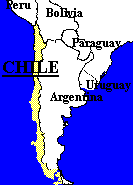
Return to * Background Contents * Top Ten * WRR39 * RIC Main Page
Chile
Background Information

Basic Indicators
| Population | 14.04 million |
| Pop. Growth | 1.61% p.a. |
| Land Area | 748,800 sq km |
| GNP per capita | 3,520 current US$ |
| Life Expectancy | 75.10 years |
ENVIRONMENT
Flanked by the Andes mountain range in the east and the Pacific in the west, the country is a thin strip of land 3,500 km long and never wider than 402 km. Its length explains its variety of climates and regions. Due to the cold ocean currents, the northern territory is a desert. The central region has a mild climate which makes it good for agriculture. The southern part of the country is colder and heavily wooded. The major salt and copper mines are located in northern Chile. 65% of the population live in the central valleys. During the military regime, some 40 thousand hectares of native forests were cut down each year, and replaced by other tree species, causing the displacement and death of wildlife.
SOCIETY
Peoples: Chileans result from ethnic and cultural integration between the native American population and European immigrants. 300,000 Mapuche live mainly in southern Chile. Religions: Mainly Catholic (77%), Protestant 13%. Languages: Spanish. Political Parties: The Christian Democratic Party (PDC); the Democratic Party (PPD);the Socialist Party (PS) and the Radical Party (RP). The National Renovation Party (RN) and the Independent Democratic Union (UDI). Democratic Alliance; Union of Center Center (UCC); National Party (PN); Communist Party of Chile (PCCh); Revolutionary Movement of the Left (MIR); the Manuel Rodríguez Patriotic Movement (MPMR); Humanistic Party (PH); the Green Party. Social Organizations: The Central Workers“ Union (CUT), the main labor organization until 1973, had been banned during the dictatorship, and became legal again in 1990. Other trade unions are: the Copper Workers´ Confederation (CTC) led by Rodolfo Seguel; the Confederation of Civil Servants of Chile (CEPCH), led by Federico Mujica; the National Association of Civil Servants; the United Workers“ Front (FUT); the National Labor Co-ordination Board (CNS); the National Federation of Taxi Drivers, and unions representing artists, petroleum workers professionals and truck drivers; the Democratic Workers“ Union (UDT), and the National Union of Civil Servants.
THE STATE
Official Name: República de Chile. Administrative divisions: 13 Regions and the Metropolitan Area of Santiago. Capital: Santiago, 4,628,300 inhab. (1993). Other cities: Viña del Mar 319,400 inhab.; Concepción 318,100 inhab.; Valparaiso 301,700 inhab.; Temuco 262,600 inhab. (1992). Government: Eduardo Frei, President since March 11, 1994. National Holiday: September 18, Independence Day (1810). Armed Forces: 93,000 troops (1994). Paramilitaries: Carabineros, 31,000.
Source: World Guide 1997/98 courtesy of New Internationalist ![]()
Return to * Background Contents * Top Ten * WRR39 * RIC Main Page